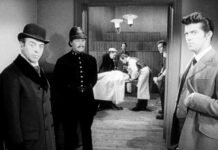ANDREW GARVEY ventures in the world of Jack the Ripper by reading the new sensational book, Naming Jack the Ripper by Russell Edwards
First off, a quick disclaimer. I’m no Jack the Ripper expert. I’ve read a little and I know the basics. But I am a historian and a writer. And I’m greatly interested in the late 19th century. And after being unable to avoid recent headlines about the identity of the Ripper finally being revealed, I decided to give Russell Edwards’ book Naming the Ripper a try.
My Spooky Isles colleague Jon Rees, a proper Ripperologist and one with a much better handle on the science than I have, has already weighed in on Edwards’ book with his article, Has DNA proved Aaron Kominski was Jack the Ripper?
For this review, I’m mostly concerned with the way Edwards tells his tale, if the book is an enjoyable read and whether he comes across as credible or just the latest hack peddling a crackpot theory.
Extraordinary Claims
Early on, Edwards proclaims that “unlike anyone before me, I believe I have incontrovertible proof, the kind of proof that would stand up to any cross-examination in a courtroom today.”
As any good sceptic knows, extraordinary claims demand extraordinary evidence. Having made such a bold claim, Edwards needs to provide some serious evidence to be taken seriously. And while the science is promising, and at times he builds a strong case for his chosen Ripper, the book ultimately fails, largely due to gaping flaws in his thinking and approach.
And worse, while failing to do that, he fails on plenty of other levels too. Coming across as pompous and arrogant certainly doesn’t help make the book any more readable. The first chapter is for some reason devoted to the self-congratulatory tale of his own rags-to-riches life story and general brilliance. You’re better off skipping it completely.
And while I’m sure the period when he was homeless was a tough one, his claim that it gave him an affinity for the desperate poverty of the Ripper’s victims is more than a bit risible. Homeless he might have been, but he also had a full time job and money invested in property. He was hardly selling his body in dingy alleyways for a few pence a go – in the 1880s.
The Killings
By the second chapter and through chapter six, we’re heading into a basic retelling of the Ripper story. Frustratingly, despite Edwards throwing out numbers and statistics to back up his description of life in the East End in the 1880s, nothing is properly referenced, making it tough to check for accuracy.
His account of the killings is also maddeningly littered with references to himself. He knows the distance from one murder scene to another because he’s walked it himself, many times, briskly, slowly, dodging in and out of alleyways like a spy in a low rent straight-to-DVD thriller. He knows this area well, and that one, and that one. It all gets very tiresome. There’s simply no need for it. Not at this stage of the book anyway.
‘Hard Evidence’
Even worse, he continually adds in unsubstantiated details, justified, he seems to think by a ‘probably’ here or a ‘possibly’ there. He makes assumptions like there’s a shortage of them and he absolutely has to have just one more, all the while sternly telling us he doesn’t deal in “supposition”, but hard evidence.
Yet his account of how the pivotal shawl (on which his entire theory rests) originally went from the Catherine Eddowes murder scene to the descendants of policeman Amos Simpson is just staggering in its lack of believability.
“Acting Sergeant Simpson… asked another, more senior officer if he could have this piece of clothing… He wanted it for his wife, because the silk was clearly of good quality, and he thought she might be able to use it for her dressmaking.”
“By today’s standards of policing,” he explains, presumably with a straight face, “it was shoddy to remove a possible piece of evidence. But in those days, there was no importance attached to the belongings of a victim because without the benefit of the modern forensic tests we can carry out today, they added nothing to the investigation.”
What?
He expects us to believe it was an acceptable practice for the police to swipe whatever goods they fancied from the recently deceased? Leaving aside the blindingly obvious moral and ethical issues, if that was the case, why did they even bother to make a list of her possessions? What exactly would be the point if anything and everything found at a crime scene were fair game for any copper who fancied a trinket or a keepsake for themselves?
The Shawl
The shawl, actually described as a dress in a few press reports was absent from that police list. Not surprising really, since the light-fingered Simpsons had apparently swiped it. Edwards declares “we can only assume the press included this description… because a journalist was either present at the scene and glimpsed the material… or that they talked to policemen who were there…”
We can assume many, many things. It doesn’t make them true.
Since the shawl is the centrepiece of Edwards’ theory he bends over backwards to find ways of linking it to the Eddowes’ murder and the man he’s already and very clearly long since decided he’s going to name as the Ripper – Aaron Kosminski.
Even while acknowledging the unreliability of family histories and recollections passed down through the generations, he’s perfectly happy to accept the shawl’s far from certain provenance precisely because it fits with what he already wants to prove. This is history done badly.
The Science
Things greatly improve once Edwards begins describing the actual scientific investigation. His DNA expert Jari Louhelainen has excellent credentials, the processes he uses are clearly described and Edwards picks out the flaws with previous, more primitive DNA tastes done on the shawl.
However, not yet peer reviewed, the very intriguing science Edwards hangs his theory on, teetering atop a rickety scaffold of earlier supposition and assumption, is far from “incontrovertible”. That Edwards so obviously thinks it is shows a fundamental lack of understanding on his part of how science works and progresses.
Why Kosminksi?
As noted earlier, it seems as though Edwards decided Aaron Kosminski was the Ripper and then set about finding any way he can to prove it. To this end, he devotes a short chapter to dismissing the possibility of other leading suspects.
Oddly enough, he completely fails to offer any reason why he dismisses one of them – Montague Druitt. No, Edwards is far too concerned with brushing aside any inconvenient discrepancies and obstacles to nailing Kosminski to fully consider other possibilities.
Amusingly, this from the same man who sneers at those who, in discussing the Ripper “fight their corner in internet forums, with exasperatingly long arguments” that demonstrates “the lengths some enthusiasts will go to prove a point.” Like writing a book, perhaps?
In fairness, Edwards does build a fairly solid case for Kosminski’s guilt. But his willingness to brush off anything that doesn’t fit the theory is troubling for a reader not as single-mindedly focused on the supposedly schizophrenic Pole. There are discrepancies in the Swanson marginalia that call into question the bits Edwards fervently believes in, but these are breezily dismissed.
The Schizophrenic Ripper
Ah yes, along the way, Edwards diagnoses Kosminski’s illness. “The eruption of schizophrenic episodes and the periods of calm between them possibly explains why somebody like Aaron Kosminski could appear harmless much of the time… and yet be capable of terrible violence.
The choice of victims all from a certain class of women suggests that he felt compelled by his delusions to wreak out his fury on them. Prostitutes were all around him on the streets of the East End, and their pretence fed these delusions.”
Or, to explain things differently, the perfectly sane sociopath with a liking for carving up women could easily find prey amongst East End prostitutes because they were plentiful and vulnerable. And he was able to “appear harmless” because serial killers tend to be good at hiding their darker urges and crimes. That’s how they end up as serial killers – not getting caught after the first one.
Edwards seems not to have considered this for a second, again because it doesn’t fit with his already decided narrative.
And Finally
So, finally, Edwards has reached his verdict and here’s mine. I think there’s a decent chance Kosminski did it. But then, this is the only full Ripper book I’ve ever read. That’s probably the very least I should think, especially with all that “incontrovertible” stuff about funky new DNA science.
The flaws in Edwards’ arguments are just too numerous, too serious yet too easily dismissed by the author to make him credible enough to fully buy into his theory. For that reason, the book is hugely frustrating, although it’s more than interesting enough to be worth a read. But remember, approach, and read, with caution.










I still getting the confirmation. Of the aron theory I know an three mason that’s high up in the order and he checking it with the info we got on the paranormal investergation